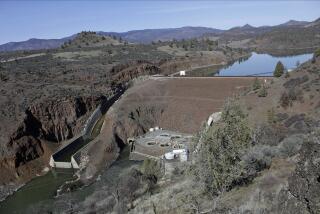China Races Flood to Save Its History
SHIBAOZHAI TEMPLE, China — For 500 years, Shibaozhai has sat on a hillside overlooking a crowded medieval village and the terraced green fields of the narrow Yangtze River valley.
It has survived civil war and the relic-smashing fanatics of the 1966-76 Cultural Revolution. But now the 12-story Taoist temple faces a new threat from the reservoir that will soon start to fill behind the massive Three Gorges Dam.
Chinese government engineers have a novel protection plan: a 33-foot thick concrete dike that will turn the temple into a tiny island within the vast man-made lake.
The plan is part of a $125-million push to save thousands of relics threatened by the world’s largest hydroelectric project.
Plans call for moving hundreds of old stone bridges, pagodas and temples that sit along a river that was a major shipping route for more than 2,000 years.
Ancient tombs and prehistoric campsites are also to be excavated before the flood waters arrive June 2003. These could hold clues into the origins of one of the world’s oldest civilizations--and human evolution itself.
Beijing is calling it the biggest historical salvage operation ever. But many experts still fret that it is too little, too late.
The Chinese government didn’t start paying for large-scale preservation until 1999, after pressure from home and abroad. Archeologists say that hasn’t given them enough time to excavate even a tenth of about 800 known sites--not to mention those yet undiscovered.
“It would take 500 years to find all the archeological treasures in the Three Gorges,” said Sun Hua, a Beijing University archeologist leading one of the digs.
Beijing has rejected requests to delay the reservoir’s start date, partly out of concern over the controversy that surrounds the $25-billion project.
The government calls the dam necessary to prevent deadly floods and generate clean power for economic development. But it will displace 1.13 million people by the time its 411-mile-long reservoir finishes filling in 2009.
Critics also fault it for doing irreparable damage to the environment and wiping out priceless clues into China’s past.
For some of the objects that can’t be moved, novel preservation plans are afoot. One proposal calls for building an underwater museum reached by an enclosed walkway to see ancient calligraphy carved into cliffs by imperial poets.
At Shibaozhai temple, the reservoir will reach the first story. Planners say relocating the red-painted wooden structure is impossible because of its unique construction directly into the hill. The $10-million dike will keep the temple dry within a shallow concrete well, but curators have misgivings about its new island setting.
“It will never be the same,” said Zheng Xiannong, deputy director of the government office that now runs the temple, near the city of Zhongxian in the central region of Chongqing.
At greater risk are the far more ancient objects on the Yangtze’s banks. Critics say too few of the people digging there have professional training, leading to the damage or inadvertent discarding of valuable artifacts.
And with China viewing the Three Gorges Dam as a symbol of national prestige, few foreign experts have been allowed to help preservation efforts.
Looting has also been a headache. Thieves armed with cell phones and metal detectors found a 2,000-year-old suit of armor and a bronze candelabra called the “Spirit Tree” that sold for $2.5 million at a New York auction in 1998.
Still, tens of thousands of relics have been saved, including gold-plated tables and chairs, jade swords and bronze spear points and daggers. Many artifacts date to China’s oldest dynasties.
Of particular interest is evidence about the Ba people, vanquished by imperial Chinese armies more than 1,600 years ago. Archeologists hope to solve the riddle of how the Ba built the boat-shaped coffins that still hang high in the gorges of Yangtze tributaries, and learn the truth of ancient legends that they sacrificed humans to tigers.
Even more intriguing are the fragments of jaws and teeth first found in 1985 near Wushan, a city sitting in the reservoir’s path.
Some Chinese scientists contend they belonged to human ancestors who lived along the Yangtze 2 million years ago. That has given rise to theories--rejected by non-Chinese scholars--that homo sapiens appeared in Asia at the same time or even before Africa.
“There are so many things we may never know now. It’s a terrible, terrible loss,” said Harvard University scholar Deirdre Chetham.
More to Read
Sign up for Essential California
The most important California stories and recommendations in your inbox every morning.
You may occasionally receive promotional content from the Los Angeles Times.









